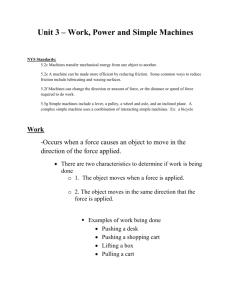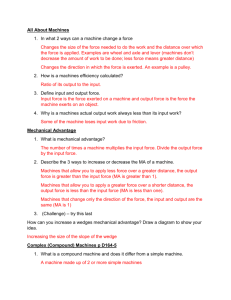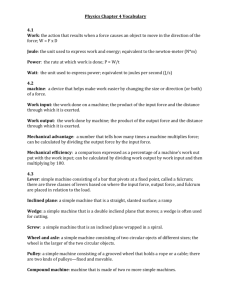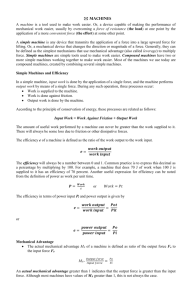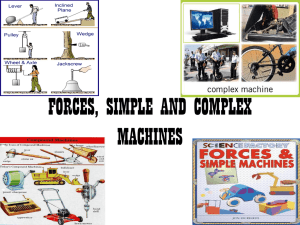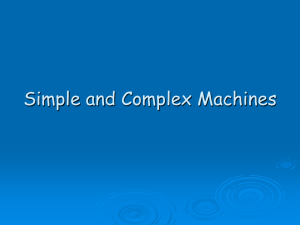S - Merryhill School
advertisement
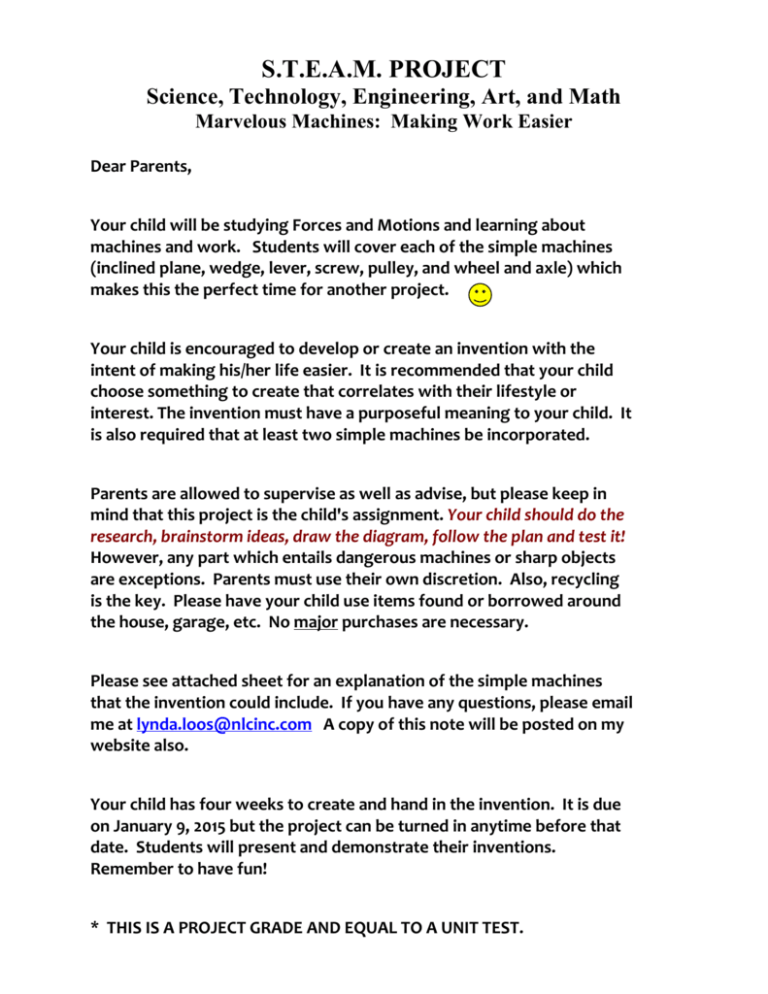
S.T.E.A.M. PROJECT Science, Technology, Engineering, Art, and Math Marvelous Machines: Making Work Easier Dear Parents, Your child will be studying Forces and Motions and learning about machines and work. Students will cover each of the simple machines (inclined plane, wedge, lever, screw, pulley, and wheel and axle) which makes this the perfect time for another project. Your child is encouraged to develop or create an invention with the intent of making his/her life easier. It is recommended that your child choose something to create that correlates with their lifestyle or interest. The invention must have a purposeful meaning to your child. It is also required that at least two simple machines be incorporated. Parents are allowed to supervise as well as advise, but please keep in mind that this project is the child's assignment. Your child should do the research, brainstorm ideas, draw the diagram, follow the plan and test it! However, any part which entails dangerous machines or sharp objects are exceptions. Parents must use their own discretion. Also, recycling is the key. Please have your child use items found or borrowed around the house, garage, etc. No major purchases are necessary. Please see attached sheet for an explanation of the simple machines that the invention could include. If you have any questions, please email me at lynda.loos@nlcinc.com A copy of this note will be posted on my website also. Your child has four weeks to create and hand in the invention. It is due on January 9, 2015 but the project can be turned in anytime before that date. Students will present and demonstrate their inventions. Remember to have fun! * THIS IS A PROJECT GRADE AND EQUAL TO A UNIT TEST. S.T.E.A.M. PROJECT OBJECTIVE: MAKE A COMPOUND MACHINES USING SIMPLE MACHINES ASK: What’s the problem” What have others done? IMAGINE: What are some solutions? Brainstorm ideas. Choose the best one. PLAN: Draw a diagram. Make a list of materials you’ll need. CREATE: Follow your plan and create it. Test it out! IMPROVE: Make your design even better. Test it out! Websites: www.ehow.com www.miniscience.com www.scienceproject.com www.education.com/science fair/ topic – compound machines www.sciencebuddies.org What is a simple machine? What is a compound machine? A machine is a tool used to make work easier. Simple machines are simple tools used to make work easier. Compound machines have two or more simple machines working together to make work easier. In science, work is defined as a force acting on an object to move it across a distance. Pushing, pulling, and lifting are common forms of work. Furniture movers do work when they move boxes. Gardeners do work when they pull weeds. Children do work when they go up and down on a see-saw. Machines make their work easier. The furniture movers use a ramp to slide boxes into a truck. The gardeners use a hand shovel to help break through the weeds. The children use a see-saw to go up and down. The ramp, the shovel, and the see-saw are simple machines. Inclined Plane A plane is a flat surface. For example, a smooth board is a plane. Now, if the plane is lying flat on the ground, it isn't likely to help you do work. However, when that plane is inclined, or slanted, it can help you move objects across distances. And, that's work! A common inclined plane is a ramp. Lifting a heavy box onto a loading dock is much easier if you slide the box up a ramp--a simple machine. Wedge Instead of using the smooth side of the inclined plane, you can also use the pointed edges to do other kinds of work. For example, you can use the edge to push things apart. Then, the inclined plane is a wedge. So, a wedge is actually a kind of inclined plane. An axeblade is a wedge. Think of the edge of the blade. It's the edge of a smooth slanted surface. That's a wedge! Screw Now, take an inclined plane and wrap it around a cylinder. Its sharp edge becomes another simple tool: the screw. Put a metal screw beside a ramp and it's kind of hard to see the similarities, but the screw is actually just another kind of inclined plane. How does the screw help you do work? Every turn of a metal screw helps you move a piece of metal through a wooden space. And, that's how we build things! Lever Try pulling a really stubborn weed out of the ground. You know, a deep, persistent weed that seems to have taken over your flowerbed. Using just your bare hands, it might be difficult or even painful. With a tool, like a hand shovel, however, you should win the battle. Any tool that pries something loose is a lever. A lever is an arm that "pivots" (or turns) against a "fulcrum" (or point). Think of the claw end of a hammer that you use to pry nails loose. It's a lever. It's a curved arm that rests against a point on a surface. As you rotate the curved arm, it pries the nail loose from the surface. And that's hard work! Wheel and Axle The rotation of the lever against a point pries objects loose. That rotation motion can also do other kinds of work. Another kind of lever, the wheel and axle, moves objects across distances. The wheel, the round end, turns the axle, the cylindrical post, causing movement. On a wagon, for example, the bucket rests on top of the axle. As the wheel rotates the axle, the wagon moves. Now, place your pet dog in the bucket, and you can easily move him around the yard. On a truck, for example, the cargo hold rests on top of several axles. As the wheels rotate the axles, the truck moves. Pulley Instead of an axle, the wheel could also rotate a rope or cord. This variation of the wheel and axle is the pulley. In a pulley, a cord wraps around a wheel. As the wheel rotates, the cord moves in either direction. Now, attach a hook to the cord, and you can use the wheel's rotation to raise and lower objects. On a flagpole, for example, a rope is attached to a pulley. On the rope, there are usually two hooks. The cord rotates around the pulley and lowers the hooks where you can attach the flag. Then, rotate the cord and the flag raises high on the pole. If two or more simple machines work together as one, they form a compound machine. Most of the machines we use today are compound machines, created by combining several simple machines. Can you think of creative ways to combine simple machines to make work easier? Think about it. QuickTime™ and a decompressor are needed to see this picture.


